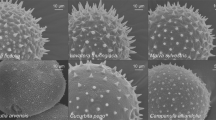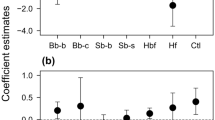Abstract
Bee-pollinated plants face the dilemma that bees do not only transport pollen grains between flowers as pollen vectors but also collect large amounts of pollen that is withdrawn from pollination. Here, we show that pollen of the common hollyhock, Alcea rosea, is mechanically protected against collection by corbiculate bees. In a laboratory setup, bumblebees did not collect the large, sticky, and spinose pollen grains of A. rosea from artificial flowers unless following manipulation of the spines or the pollenkitt. Following removal of the sticky pollenkitt or bending the spines by vortexing the bumblebees readily collected the pollen. Our results show that the pollen of A. rosea is not bitter-tasting or toxic, but mechanically protected by the spines against being collected by corbiculate bees. Light microscopic (LM)-micrographs indicate that the long spines of malvaceous pollen grains are not covered by pollenkitt suggesting a new mechanism of mechanical defense against collection: pollenkitt-free spines and lipophilic pollenkitt prevent compacting pollen grains into pollen storage organs of corbiculate bees. The experimental data fit to observations at flowers of A. rosea and other malvaceous plants that honeybees and bumblebees are densely dusted with pollen but discard the pollen while packing it into their corbiculae.


Similar content being viewed by others
References
Azo’o, E.M., Fohouo, F.-N.T., Messi, J. (2011) Influence of the foraging entomofauna on okra (Abelmoschus esculentus) seed yields. Int. J. Agric. Biol. 13, 761–765
Christensen, P.B. (1986) Pollen morphological studies in the Malvaceae. Grana 25, 95–117
Detzel, A., Wink, M. (1993) Attraction, deterrence or intoxication of bees (Apis mellifera) by plant allelochemicals. Chemoecology 4, 8–18
Eisikowitch, D., Loper, G.M. (1984) Some aspects of flower biology and bee activity on hybrid cotton in Arizona, U.S.A. J. Apic. Res. 23, 243–248
Gaglianone, M.C. (2000) Behavior on flowers, structures associated to pollen transport and nesting biology of Perditomorpha brunerii and Cephalurgus anomalus (Hymenoptera: Colletidae, Andrenidae). Rev. Biol. Trop. 48, 89–99
Harder, L.D., Thomson, J.D. (1989) Evolutionary options for maximizing pollen dispersal of animal-pollinated plants. Am. Nat. 133, 323–344
Hargreaves, A.L., Harder, L.D., Johnson, S.D. (2009) Consumptive emasculation: the ecological and evolutionary consequences of pollen theft. Biol. Rev. 84, 259–276
Johnson, S.D., Edwards, T.J. (2000) The structure and function of orchid pollinaria. Plant Syst Evol. 222, 243–269
Knoll, F. (1930) Über Pollenkitt und Bestäubungsart. Z. Bot. 23, 610–675
Leadbeater, E., Chittka, L. (2007) The dynamics of social learning in an insect model, the bumblebee (Bombus terrestris). Behav. Ecol. Sociobiol. 61, 1789–1796
Lunau, K. (2000) The ecology and evolution of visual pollen signals. Plant Syst Evol. 222, 89–111
Lunau, K., Papiorek, S., Eltz, T., Sazima, M. (2011) Avoidance of achromatic colours by bees provides a private niche for hummingbirds. J. Exp. Biol. 214, 1607–1612
Luo, Z., Zhang, D., Renner, S.S. (2008) Why two kinds of stamens in buzz-pollinated flowers? Experimental support for Darwin’s division-of-labour hypothesis. Funct. Ecol. 22, 794–800
Nepi, M., Franchi, G.G. (2000) Cytochemistry of mature angiosperm pollen. Plant Syst Evol. 222, 45–62
Pacini, E. (2000) From anther and pollen ripening to pollen presentation. Plant Syst Evol. 222, 19–43
Pacini, E., Hesse, M. (2005) Pollenkitt - its composition, forms and functions. Flora 200, 399–415
Papiorek, S., Rohde, K., Lunau, K. (2013) Bees’ subtle colour preferences: How bees respond to small changes in pigment concentration. Naturwissenschaften 100, 633–643
Praz, C.J., Müller, A., Dorn, S. (2008) Specialized bees fail to develop on non-host pollen: do plants chemically protect their pollen? Ecology 89, 795–804
Roulston, T.H., Cane, J.H. (2000) Pollen nutritional content and digestibility for animals. Plant Syst Evol. 222, 187–209
Schlindwein, C., Pick, R.A., Martins, C.F. (2009) Evaluation of oligolecty in the Brazilian bee Ptilothrix plumata (Hymenoptera, Apidae, Emphorini). Apidologie 40, 106–116
Shaheen, N., Khan, M.A., Yasmin, G., Hayat, M.Q., Munsif, S., Ahmad, K. (2010) Foliar epidermal anatomy and pollen morphology of the genera Alcea and Althaea (Malvaceae) from Pakistan. Int. J. Agric. Biol. 12, 329–334
Thorp, R.W. (1979) Structural, behavioral, and physiological adaptations of bees (Apoidea) for collecting pollen. Ann. Mo. Bot. Gard. 66, 788–812
Thorp, R.W. (2000) The collection of pollen by bees, Plant Syst. Evol. 222, 211–223
Vaissière, B.E., Vinson, B. (1994) Pollen morphology and its effect on pollen collection by honey bees, Apis mellifera L. (Hymenoptera: Apidae), with special reference to upland cotton, Gossypium hirsutum L. (Malvaceae). Grana 33, 128–138
Westerkamp, C. (1996) Pollen in bee-flower relations. Some considerations on melittophily. Bot Acta 109, 325–332
Westerkamp, C., Claßen-Bockhoff, R. (2007) Bilabiate flowers - the ultimate response to bees? Ann. Bot. 100, 361–374
Acknowledgments
We thank Amots Dafni, Dan Eisikowitch, and Michael Hesse for critical discussions about pollen packaging and pollen sculpturing.
Author information
Authors and Affiliations
Corresponding author
Additional information
Justement des épines – Défense mécanique du pollen de malvacées contre la récolte par des abeilles corbiculées
Mécanisme de défense / récolte du pollen / Alcea rosea / pollenkitt / corbeille à pollen / abeille / Bombus terrestris
Ausgerechnet Stacheln – Mechanischer Schutz von Malvaceae-Pollen vor dem Sammeln durch corbiculate Bienen
Pollen / Pollenkitt / mechanischer Schutz / corbiculate Bienen / Alcea rosea
Manuscript editor: Yves Le Conte
Electronic supplementary material
ESM 1
Supplement 1
Bumblebee that has buzzed hollyhock pollen from a pipette tip offered in an emasculated Oenothera flower trying to package the pollen into the corbiculae while flying (JPEG 1,128 kb)
Supplement 2
Bumblebee fails to package the pollen into the corbiculae. Note the pollen mass falling down (JPEG 1,039 kb)
Rights and permissions
About this article
Cite this article
Lunau, K., Piorek, V., Krohn, O. et al. Just spines—mechanical defense of malvaceous pollen against collection by corbiculate bees. Apidologie 46, 144–149 (2015). https://doi.org/10.1007/s13592-014-0310-5
Received:
Revised:
Accepted:
Published:
Issue Date:
DOI: https://doi.org/10.1007/s13592-014-0310-5




